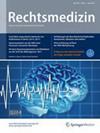或是烂醉如泥?
IF 0.5
4区 医学
Q4 MEDICINE, LEGAL
引用次数: 0
摘要
背景在尸检血液酒精浓度(BAC)的评估中出现了几个陷阱。本研究的目的是在猪模型中以控制和系统的方式评估死后同系物模式是否可以为死前或死后乙醇新生提供证据。方法6头猪静脉注射乙醇,其余6头猪保持清醒状态。给药1h后安乐死,取外周血、心脏血(HB)及肌肉组织。动物在室温下保存,每天收集上述范围的样品,连续3天。采用顶空气相色谱-质谱联用技术对样品中乙醇及同类物质进行分析。结果在贮藏过程中,在清醒的猪体内观察到乙醇的形成,导致平均BAC为0.24 g/kg体重。猪的血液酒精浓度相对稳定。此外,观察到正丙醇、正丁醇和乙醛的明显增加。清醒动物储存后的正丙醇血中位数浓度高于饮酒猪,但两组之间无显著差异(p >0.05)。清醒猪血红蛋白中乙醛和正丁醇浓度在3天后上升至饮酒猪死亡时的水平。直到实验结束(死后3天),均未检测到浓度的显著差异。肌肉组织中的浓度没有增加到同样的程度。在目前的研究中,没有能够确定的标志物可以可靠地区分死前乙醇摄入和死后发生。本文章由计算机程序翻译,如有差异,请以英文原文为准。
Betrunken oder doch nur verwest?
Abstract Background Several pitfalls arise in the assessment of postmortem blood alcohol concentrations (BAC). The purpose of the present study was to evaluate in a controlled and systematic manner in a porcine model whether a postmortem congener pattern can provide evidence for antemortem or postmortem ethanol neogenesis. Methods Ethanol was administered intravenously to six pigs, whereas six control pigs remained sober. The animals were euthanized 1h after the start of administration, and peripheral and heart blood (HB) as well as muscle tissue were collected. The animals were stored at room temperature and the aforementioned range of samples was collected daily for 3 days. Samples were analyzed for ethanol and congener substances by headspace gas chromatography-mass spectrometry. Results Over the course of storage, ethanol formation was observed in the sober pigs, resulting in a median BAC of 0.24 g/kg body weight. The BAC in the pigs with alcohol remained comparatively stable. In addition, a distinct increase in n‑propanol, n‑butanol, and acetaldehyde was observed. The median blood concentration of n‑propanol in sober animals was higher after storage than that of pigs with alcohol, but no significant differences could be substantiated between the two groups ( p > 0.05). Acetaldehyde and n‑butanol concentrations in HB of the sober pigs increased to the level of the pigs with alcohol at death after 3 days. Until the end of the experiment (3 days postmortem), no significant differences in concentrations were detected. Concentrations in muscle tissue did not increase to the same extent. Discussion In the present study, no marker could be identified that could reliably discriminate antemortem ethanol ingestion from postmortem genesis.
求助全文
通过发布文献求助,成功后即可免费获取论文全文。
去求助
来源期刊

Rechtsmedizin
MEDICINE, LEGAL-
CiteScore
1.30
自引率
40.00%
发文量
45
审稿时长
6-12 weeks
期刊介绍:
Rechtsmedizin is an internationally recognized journal dealing with all aspects of forensic medicine. It provides information on current developments in forensic pathology, traumatology, traffic medicine, toxicology, serology, insurance medicine, psychopathology and legal medical issues.
Freely submitted original papers allow the presentation of important clinical studies and serve scientific exchange.
Case reports feature interesting and unique cases thus providing a platform for scientific information and critical discussion.
Comprehensive reviews on a specific topical issue focus on providing evidenced based information on all aspects of the field.
Review articles under the rubric ''Continuing Medical Education'' present verified results of scientific research and their integration into daily practice.
 求助内容:
求助内容: 应助结果提醒方式:
应助结果提醒方式:


